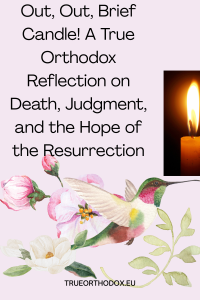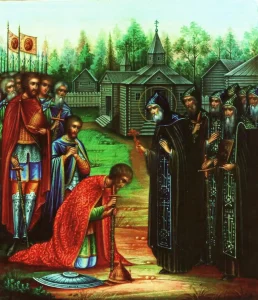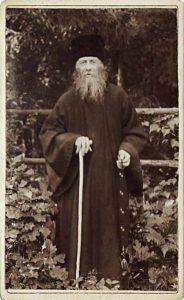The Reunification of the Russian Church by Vladimir Moss

The Reunification of the Russian Church
Vladimir Moss: The Reunification of the Russian Church

From the year 2000, as the Synod of ROCOR began officially to accept the canonicity of the MP and initiated union talks with it, the Church both inside and outside of Russia that remained faithful to the truth began to separate into so-called “splinters” (oskolki), small Synods not in communion with each other. Most of them claimed that their canonical existence, like that of ROCOR, was based on Patriarch Tikhon’s ukaz no. 362. However, as Igumen (now Bishop) Andrei (Erastov) argued earlier this year, strictly speaking, neither ROCOR in the 1920s nor, still less, the “splinters” of the early 2000s, ever corresponded to the conditions for the existence of the autonomous groups of bishops envisaged by the Patriarch’s ukaz, so that a canonical basis for the present-day True Orthodox Church of Russia must be sought elsewhere.
Let us examine Igumen Andrei’s argument, and his proposed solution to the problem of the “splinters”.
“It is completely obvious,” he writes, “that it is impossible now even to imagine a single administrative centre of the Russian Church. On the other hand, it is possible that its existence would not be useful. Church life, both in Russia and abroad, must be built on the basis of ukaz №362 as the basic guiding canonical document. In correspondence with this ukaz, church districts must be formed on voluntary principles; they must consist of several dioceses (no less than three or four). (A Church can be autocephalous only if can itself and install and judge its own bishops. For the election of a new bishop three diocesan bishops must participate and confirm a fourth as the metropolitan. (Fourth Canon of the First Ecumenical Council.)) These districts will be temporarily autonomous until the restoration of a lawful, canonical Higher Church Authority in the Russian Church.
“The hierarchs will have to elect from their midst a first-hierarch, in relation to whom they will carry out the obligations imposed by the 34th Apostolic canon. Such districts will maintain Eucharistic communion between themselves, together with close links expressed in fraternal communion and mutual support. At times they will gather together in common councils to resolve general church questions. However, from an administrative point of view each district will be independent. It is not difficult to see that such an organization of the Church will be a return to the canonical forms of the early Christians such an organization of the Church will be a return to the canonical forms of the early Christians.”
This extract already displays considerable confusion of thought. First, the author questions whether an administrative centre of the Russian Church is imaginable or even desirable. But then he suggests returning to the application of ukaz №362 as the basic guiding canonical document. Fine; but this ukaz was issued by the administrative centre of the Russian Church and presupposes that such a centre is both imaginable and desirable… Then the author appears to concede that such a centre is indeed desirable; for he writes that the church districts “will be temporarily autonomous until the restoration of a lawful, canonical Higher Church Authority in the Russian Church”. But then he contradicts himself by declaring that “such an organization of the Church will be a return to the canonical forms of the early Christians” – when there were no Higher Church Administrations above the metropolitan level, no ukaz №362 and no national Churches such as the Russian. So which is it? Is Igumen Andrei proposing a reconstruction of the unity of the national Church of Russia, or the radical decentralization of the Church on the model of the Early Church? The latter is by no means an impossibility, but it runs up against the insuperable obstacle that it requires that all the Local True Orthodox Churches – the Russian, the Greek, the Serbian, etc. – should announce their dissolution as national Churches and their reformation as independent metropolitan districts having no national mark or obedience to any national Church. However, it seems that nobody – except, perhaps, the name-worshipping “Bishop” Gregory (Lurye) – is even contemplating such a thing…
He continues: “Church formations on the model of church districts – the so-called ‘splinters’ – have already been formed among us historically. Of course, these church formations have great faults, for example, the fact that they overlap each other territorially. But they have one important merit – they already exist. Church construction has in mind already existing building material. In fact, the problem of the ‘splinters’ does not lie in their splintering. – this splintering has its positive sides, and is completely canonical. That is how the Church looked in antiquity, and such a splintering is envisaged by ukaz №362. The main problem of the ‘splinters’ lies in the fact that there is no liturgical communion between them, and many of them have no conciliarity.
“At the basis of liturgical communion between the ‘splinters’, as in the early Church, there have to be: an Orthodox confession [of faith] and the lawfulness of the hierarchy. Eucharistic communion is impossible only with non-Orthodox, with those who do not have a correct ordination or with banned clergy. If these obstacles do not exist, then there is no reason to reject serving together. We must all reject the abnormality of the situation when Orthodox hierarchs have no Eucharistic communion with each other and do not care about that fact.”
Here at last we come to the nub of the situation. Igumen Andrei correctly observes that ukaz №362 cannot be applied at the present time because conditions have changed radically since the 1920s: communications are better, but there is no central authority for the splinters to communicate with; the splinters overlap each other territorially; and, still more important, there is no agreement in faith and therefore Eucharistic communion between them. However, he still seems to think that, for lack of anything better, we must make do with ukaz№362 as a basis for church unity. But how can an ukaz that cannot be applied to the present situation because of the factors mentioned above form the basis for church unity?! Although the ukaz was undoubtedly inspired by the Holy Spirit and was important for preserving church unity in the Soviet period, it presupposed an already-existing unity in faith which no longer exists; so it cannot be used as a basis for recreating that unity which is the essential condition for any serious work in church building.
“The principle expressed in ROCOR’s Statute: ‘The Russian Church Abroad is an unbreakable part of the Local Russian Orthodox Church temporarily self-governing on conciliar principles’ remains in force. However, it must be applied not to any single part of the Church, but to all of them together.”
All of them together? Even when they are not in communion with each other, and when they believe different things? This is “Catacomb Church ecumenism” and quite unacceptable!
“The ‘splinters’ dispute with each other over who has the right of succession from the pre-schism Church Abroad. However, it no longer exists. As was said before, the ROCOR Synod existed, not on the basis of any canonical acts, but in spite of them. The meaning of the existence of the Synod lay in the fact that it was the bearer of Church truth. But when the Synod later fell into the deception of Sergianism, it lost all significance. The canonical basis of the Synod lay in its lofty spiritual-moral authority and in considerations of what is profitable for the Church. (‘What is useful for the Church is canonical’ (V.V. Bolotov).)
This again makes no sense. However great the authority of V.V. Bolotov, the expression “What is useful for the Church is canonical” is not sanctioned by Church tradition. For who is to say what is useful for the Church? Many ecumenists have considered following the canons about, for example, concelebration with heretics, to be not useful for the Church. Are they to be allowed to redefine what is not canonical as canonical simply because it is “useful” to them?! The MP is doing something similar now, issuing “canonical” rebukes to those who question the canonicity of the ecumenical movement… [5]
He continues: “Therefore, before the restoration of a Higher Church Administration, the Russian Local Church must be composed of church districts in liturgical communion with each other. The process of the ‘splinters’’ unification must not be seen in their merging together, into one structure or in the submission of all of them to one centre, but in the establishment of Eucharistic and fraternal communion, instead of the present rivalry, claims and mutual excommunications.
“The principle expressed in ROCOR’s Statute: ‘The Russian Orthodox Church Abroad is an unbreakable part of the Russian Orthodox Church temporarily self-governing on conciliar principles’ remains in force. However, it must be referred, not to any one part of the Church Abroad, but to all the parts together.”
Again, we see a confusion between means and ends in Igumen Andrei’s argument. He says that “before the restoration of a Higher Church Administration, the Russian Local Church must be composed of church districts in liturgical communion with each other.” But they are not in communion with each other, so what are they, canonically speaking, and where is the Local Russian Church? Again, he scorns “the present rivalry, claims and mutual excommunications”, but offers no solution as to how to overcome that. He rejects the solution of “the submission of all of them to one centre” – probably because he himself has fled from “Metropolitan” Agathangel’s attempt to make himself such a centre, “not a part, but the remnant” (ne chast’, a ostatok) of the Church – but also scorns a “merging” of the splinters on any other basis.
“A strange picture emerges: the ‘splinters’ are competing for possession of a non-existent heritage. The heritage of the Church Abroad does not consist in any special canonical right – that does not exist, but in the spirit of true churchliness, in the wisdom of the royal path, which unites a firm stand in the truth and the preservation of the tradition of the Church, but without deviating into the extremes of fanaticism and sectarian thinking. Unfortunately, our ‘splinters’ are not worrying at all about acquiring this spiritual heritage of the Church Abroad.
“It is to highest degree strange when some small ‘splinter’, not having the slightest moral authority behind it, lays claim to the highest authority over the whole of the Russian Church on the basis of some incomprehensible right of succession from the former ROCOR, as, for example, was said in the ‘Declaration of the Hierarchical Council of ROCOR’”.
“The ‘splinters’ have nothing to share and no reason to compete with each other. All of them are temporarily self-administering parts of the Russian Church Abroad independently of where they are, in Russia or abroad, and no matter with what abbreviations they label themselves. However, they have to organize themselves on the principle of conciliarity in accordance with ukaz №362 so as to be transformed from ‘splinters’ into canonical Church Districts.”
A strange picture indeed! The ‘splinters’, according to Igumen Andrei, are uncanonical, and yet they have “a moral-spiritual authority”. Their existence is based on ukaz №362, and yet the basic preconditions of that ukazare nowhere fulfilled. Individually they are nothing, and yet taken together they constitute the whole of the Russian Church – so long as they can organize themselves and “be transformed from ‘splinters’ into canonical Church Districts.” But how? That question is not answered…
“Let us examine separately the question of clergy bans to which several ‘splinters’ have been subjected. The hierarchy of the majority of the ‘splinters’ has undoubted apostolic succession, but their canonicity remains under question because these ‘splinters’ at their foundation were evaluated as schism and their episcopate was placed under ban.
“Clergy bans can be imposed with various aims and have different meanings. For example, a ban can be imposed for a time, as a punishment for some act. Also, a ban can be imposed on a clergyman under accusation before an ecclesiastical court has judged him. In our case, a ban without time limit was imposed on bishops who had removed themselves from obedience to a church authority and had created their own separate jurisdiction. Such a ban is laid the disobedient so as to return them to obedience. In the history of the Church this has happened many times. Almost every time a ‘daughter’ Church separated from its mother-Church, this was linked with a schism and bans. That was the case, for example, when the Bulgarian Church separated from Constantinople in a self-willed manner in 1872.
“There are only three possible ways of removing such a ban and restoring peace in the Church. 1. If the disobedient group of bishops repents and returns into obedience to church authority. 2. If the church authority itself becomes softer and removes the ban. 3. If the church authority is unbending, those under ban can appeal to a higher ecclesiastical instance. For example, in 1935 there was a reconciliation between the Synod of the Church Abroad and Metropolitan Evlogy and Metropolitan Theofil, who returned into obedience to the Synod, and their bans were removed. But in relation to the bans placed on the ‘splinters’ by the ROCOR Synod (for example, on the Suzdal group), the problem consists in the fact that the church authority that imposed the bans no longer exists (since it has fallen into Sergianism), and so it is impossible to be reconciled and freed from the ban. For the ban can be removed only by that Church which imposed it (Apostolic Canon 32; Canon 5 of the First Ecumenical Council) or by a Church Council that is significantly more authoritative. Nor is it possible to appeal to a high ecclesiastical instance, insofar as that also does not exist for us. Of course, many ‘splinters’ claim the right of succession from the ROCOR Synod, but as has already been said, such claims are groundless. Insofar as there is no possibility, according to the canons, of removing the bans imposed by the ROCOR Synod before 2007 or by the Synod Metropolitan Vitaly (2001-2007), it makes no sense to recognize these bans. We have to consider them to be non-existent. These bans could be removed by a common council of the hierarchs of the ‘splinters’.
“As regards the mutual bans imposed by the hierarchy of the ‘splinters’ on each other, these were sometimes imposed on the basis of incorrect canonical ideas. For that reason it would be possible simply to ignore them. As one contemporary church actor says, the process of ‘the gathering of the splinters’ must at the initial stage be more ‘theoretical’, and not organizational-administrative. It is time, finally, to compose a vivid and convincing ideology, or, expressing oneself in theological language, an ‘ecclesiology of the splinters’, which would gradually become more popular and influential than the old ‘administrative-synodal’ ecclesiology.”




